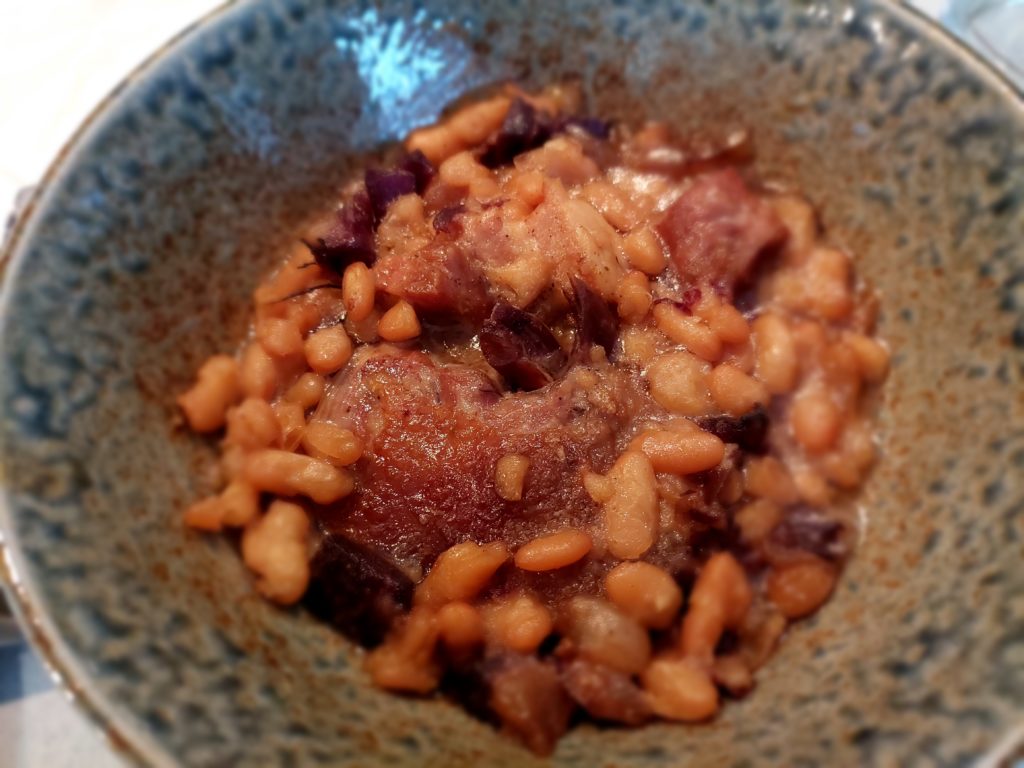Cassoulet is one of those seemingly simple monuments, but it’s very demanding in terms of cooking. Cassoulet has several lesser-known uses:
- Enhancing natural protection against winter
- Keeping dieticians at bay
- Turning my dad into a happy dad
My dad grew up in the Southwest of France, and even though he’s extraordinarily kind and always happy when I share a bit of the rpoceedings of my recipes with him, you can’t fool him with an ordinary cassoulet. So, a bit of pressure, to be honest 😀
This one is a true embodiment of slow food. It involves several steps, each requiring hours of preparation… Let me tell you (almost) everything.
For 4 portions guaranteed to make a cassoulet-loving dad happy:
- 400g white beans, Pamier lingot variety for authenticity, but almost anything would do
- 1 fat duck, cleaned and plucked ( the fat fillets will be kept for another session, not using them here)
- 50g cured ham fat not rendered
- 100g low-grade cuts of dry-cured ham (such as a hock)
- 300g fresh pork belly with its rind
- 1 Toulouse sausage or anything with an approaching format
- 1 bouquet garni
- 2 cloves
- 1 onion (if you like adding it to the broth)
First, carve the duck into pieces: fillets to be set aside for grilling later, thighs and wings for confiting.
To confit the duck: at least 3 hours at 150°C. For something even more tender, lower the temperature and increase the cooking time.
Ironically, the most interesting part is the carcass, which you’ll clean of any remaining offal.
Blanch it quickly, then prepare a broth (4-5 liters) with the bouquet garni and cloves. This will form the base for cooking the beans.
Simmer the broth for at least 5 hours on low heat to dissolve the collagen thoroughly.
Many people believe the secret to cassoulet is the fat… nope. The secret to cassoulet is collagen. The extra collagen we extract from the duck carcass will make all the difference and give our cassoulet that perfect consistency ;-). Okay, it’s partly the fat too, but mostly the collagen.
The beans need to soak for a LONG time. I insist: at least overnight, preferably a full day. I recommend rinsing and changing the water twice during rehydration. Then, optionally, let them rest uncovered in the fridge for a day to dry slightly and improve absorption of the broth.
Cut the pork belly into 4 pieces and separate the rind, scraping and scoring it.
Although cassoulet reheats well, the first cooking is the most critical.
Here’s the assembly and timeline I suggest, but it’s flexible:
Throughout the cooking process:
- Maintain a gentle simmer.
- Add broth as needed.
Honestly, the traditional cassole is a beautiful piece of cookware, but any dish that allows regular evaporation will do for a decent cassoulet.
Timeline:
- T-7h: Put the beans in the broth along with the rind and diced ham fat. Start cold and bring to a gentle simmer to begin cooking the beans.
- T-5h: Add the whole pieces of fresh pork belly and the ham.
- T-2h: Stop adding broth, remove the rind, and add the sausage and confit duck pieces.
If you’re patient, the result looks like this at the end:

